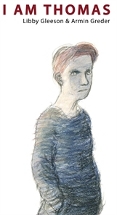I am Thomas by Libby Gleeson and Amin Greder

Allen and Unwin, 2011. ISBN 978 1742373331.
(Ages 8+) Highly recommended. Thomas is different. He is very aware of
his difference. He tells us in the first few pages that he is nor like
his brother nor the other students in his school. He retreats to his
headphones as all around him tells him that he will be a failure and
not amount to anything. He is told that people are ashamed of him and
this is in the same page as the order to clean his room, brush his
teeth and show respect. All the instructions given to kids are listed
as he watches the array of grey people around him who offer him a place
to go. The army offers serving his country, religion offers forgiveness
of sins, a politician offers being part of a democracy, but they are
all the same, grey and the same, expecting him to be the same as they
are. The bleak view of the world is an amalgam of all that is nasty,
the cloying religious zealot, the braying army personnel, the priest
offering him the seat next to him, the leering politician, the
overwhelming teachers, the dictatorial father and yet the crying,
impassive mother. A fascinating mix of a world which is absolutely
nasty. Rejecting all the pressures to conform, he boards a bus, taking
his life in his own hands.
The illustrations of Thomas' journey to retain his individuality are
amazing. The grey suited men who surround Thomas with promises and
exhortations create a claustrophobic atmosphere on many of the pages.
The men and the few women are remote, removed, emotionless, and often
portray a dictatorial approach when trying to deal with Thomas, the
outsider. The first few pages show us what Thomas likes, the model of a
plane, a globe, an atlas, but as the pages progress the colours become
more grey, the things depicted more redolent of authority and rules,
just as the last few pages revert from rules to freedom on the bus, as
colour becomes more obvious. As Thomas rejects the sterile paths
offered to him, colour returns once again. And watch out for the
contrasting items on the pages. On one page is depicted Thomas'
sandshoes, lying almost together, open with laces askew, but further up
the page in black and white is a pair of shoes, neatly laced, side by
side with the boot polish and brush neatly next to the shoes. On
another page, a man is rejecting the musical instruments in the corner,
the chess set is left awry and so on. Little gems are there to be
explored and savoured.
A most interesting book, readers will have much to discuss with their
teacher or parents as they sit together and read both the words and the
illustrations, discussing authority, rules, institutions, free will,
fitting in - the list is endless, and the bleak world portrayed too
will be the cause of discussion about what there is to be thankful for.
Fran Knight